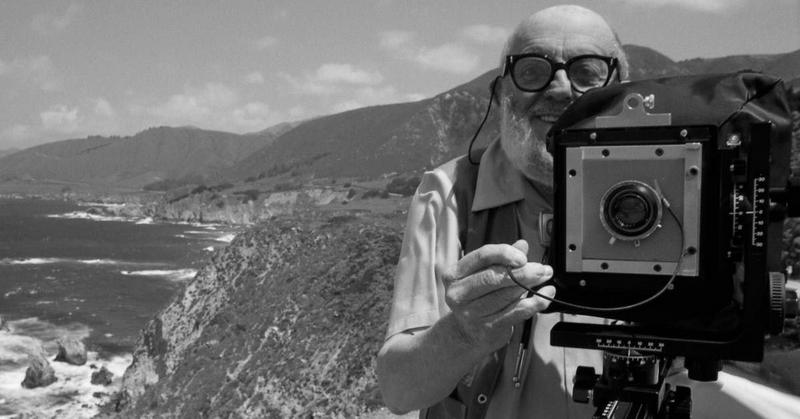Ansel Adams: Artist Biography, Facts, Trivia, & More About This Legendary Photographer
By | February 18, 2021

Even if the name Ansel Adams doesn't sound familiar, you have no doubt seen some of his work. The American landscape photographer was famous for his dramatic black-and-white images of the country's majestic national parks, most notably Yosemite, which he used to advocate for the preservation of such wild lands in addition to showcasing the beauty of the American West.

Photography Wasn't Adams's First Passion
Ansel Adams was born February 20, 1902 in San Francisco and shortly thereafter proved to be a terrible student. In fact, he was so bad at school that his father withdrew him in frustration at age 12, which would be catastrophic under normal circumstances but allowed Adams to flourish under his own tutelage. He read books on natural history and took up the piano, devoting long hours to practice until he became such an accomplished musician that he was labeled "gifted" by composer Henry Cowell.

His First Camera
Adams got his first camera when he was 14 and immediately displayed a talent for the medium. At first, Adams divided his time between photography and music, but that changed after he picked up work as the custodian of Yosemite National Park's Sierra Club Lodge. He remained employed by the club for much of the 1920s, affording him the opportunity to spend his off-time exploring the area. Many of his most dramatic and powerful photographs were taken during this time period as he fell in love with the rugged beauty of Yosemite.

The Evolution Of Ansel Adams
By the start of the 1930s, Adams had generated enough interest in his photography to devote himself to the art full-time, but his work evolved after he met fellow photographer Paul Strand. Like Adams, Strand was a landscape photographer, but he did most of his work in New Mexico, and Adams was awestruck by the play of light in Strand's work as well as the simplicity of his subject matter. At the time, most photographers favored the pictorialism style with soft edges and muted focus, but after viewing Strand's images, Adams began experimenting with more realism in his photographs.

Ansel Adams, Author
By the mid-1930s, Ansel Adams was well-known in the photographic community, so he was invited to write a series of articles for Camera Craft in addition to assignments for other periodicals devoted to photography. Although quite technical in nature, Adams's articles were clear and engaging and offered practical advice to counteract common pitfalls that amateur photographers often encountered. His articles were so popular that in 1935, a London publisher commissioned Adams to produce a book called Making A Photograph, a complete guide to photography illustrated with Adams's own photographs.

New York And Bust
Based on the enormous success of Making A Photograph, art promoter Alfred Stieglitz invited Adams to showcase his work in New York City, giving the lifelong East Coasters their first glimpse at the astonishing beauty of the American West and the wonders of Yosemite. They weren't impressed—critics panned Adams for photographing pretty lakes and mountains instead of using his skills to document the political and economic turmoil of the era.

A Hidden Message
Contrary to the complaints of the coastal elites, Adams's work was unarguably political, just not in a sense they recognized. Adams was a lifelong conservationist, serving as the director of the Sierra Club from 1934 until the early 1970s, and he used his photography from the beginning to stress the importance of preserving nature. In this mission, Adams was way ahead of his time. When the conservationist movement picked up steam in the 1960s and 1970s, it was inspired largely by Adams's 1960 book This Is the American Earth, and he lobbied tirelessly for the Wilderness Act of 1964.

Mr. Adams Goes To Washington
For his work with conservationism, Ansel Adams was presented with the Department of Interior’s highest civilian honor, the Conservation Service Award, in 1968 and the Presidential Medal of Freedom in 1980. Then-President Jimmy Carter was a big Adams fan, commenting "It is through his foresight and fortitude that so much of America has been saved for future Americans." A few years later, Adams spoke out against the environmental policies of President Ronald Reagan and Secretary of the Interior James Watt.

The Ansel Adams Wilderness
In his later years, Adams scaled back his photography, focusing instead on compiling his unpublished photos into new books and his conservation work. He died in 1984, but nearly 40 years later, his photographs are seen every day in art classes and gift shops and on the Internet. He is forever linked with his beloved Yosemite National Park, and the year of his passing, a slice of the Sierra Nevada that he'd worked so hard to protect with the Wilderness Act was renamed the Ansel Adams Wilderness Area.

